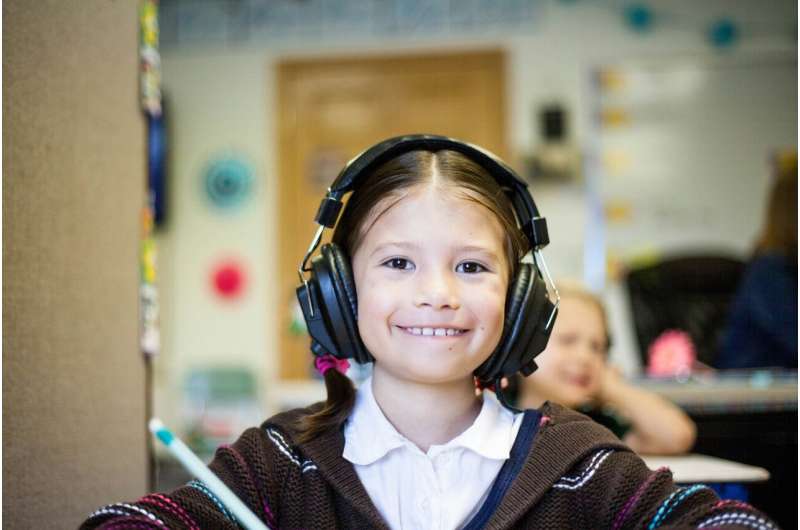
Credit: Unsplash/CC0 Public Domain
Researchers at Oregon Health & Science University are discovering the potential benefits of color noise exposure for youth with attention deficit hyperactivity disorder (ADHD).
A study published in this month’s issue of the Journal of the American Academy of Child & Adolescent Psychiatry found a small but statistically significant benefit of white and pink noise on task performance in college-age children and young adults with ADHD.
Color noises represent a different combination of frequencies and volumes along the sound spectrum, each with their own characteristics and effects on the brain. Just as white light contains all the colors of the rainbow, white noise contains all the frequencies of noise and sounds like noise. Pink and brown noise are similar but have a higher percentage of low frequencies; they can sound like rain or a waterfall.
As the clinical understanding of ADHD continues to broaden, interest has grown in identifying new, low-cost supports for those diagnosed with the disorder. One such support that has recently attracted considerable interest is the potential use of exposure to color noise, including white, pink, and brown noise, to enhance focused performance on tasks that require high attention.
“Although outcomes have improved greatly with current treatments, ADHD can still dramatically increase the risk of serious and complex long-term health outcomes because treatments are only partially effective and adherence to treatment is difficult,” said Joel Nigg, Ph.D., professor of psychiatry in the OHSU School of Medicine, co-director of the OHSU Center for Mental Health Innovation and lead author of the study. “It is critical that we continue to explore complementary and alternative supports for people with ADHD.
“Our priority is to identify new and improved tools to enable every individual to live their healthiest, most productive lives, and to provide evidence-based guidance on popular ideas in the public domain, such as white or brown noise.”
Exploring Color Noise
The systematic review and meta-analysis included 13 studies with 335 participants. It found that white or pink noise improved cognitive performance for children and young adults with ADHD or significant ADHD symptoms. In contrast, white or pink noise slightly reduced cognitive performance for individuals without ADHD or with normal attention.
Researchers say these findings point to a potential low-cost, low-risk intervention that could benefit young people with ADHD. Using white and pink noise is relatively safe, easy to implement, and accessible, Nigg said. Additionally, color noise therapies can be used inexpensively at home and in conjunction with other interventions, such as medications, with relatively few concerns about side effects.
At the same time, using color noise to improve attention is not without risk, Nigg cautioned. Hearing damage is a significant risk if volume is not carefully controlled, and other studies have shown that young people tend to use headphones at too high a volume for other activities. The effects of frequent use on children’s attention development are also unknown.
With these unknowns, creating clinical guidelines would require additional data, Nigg said. Moving forward, researchers will need to prioritize additional studies that compare white or pink noise with other environmental stimulation, such as brighter lights or other types of noise, and test the range of effect across task types and with different types and durations of auditory stimulation.
In addition, study populations should be expanded and diversified to ensure that accurate data are collected on race, ethnicity and other characteristics that could influence effects, Nigg said, noting that the lack of a large, diverse sample population was a major limitation of the study.
“While more research is needed to translate the findings into clinical practice, these initial results should be viewed as encouraging,” Nigg said.
“The results should prompt further work to clarify who might benefit and what dosages and amounts are safe and appropriate. Supportive interventions remain needed for ADHD, which affects millions of children and adolescents worldwide.”
More information:
Joel T. Nigg et al, Systematic review and meta-analysis: Does white noise or pink noise aid task performance in youth with attention-deficit/hyperactivity disorder or with increased attention problems?, Journal of the American Academy of Child & Adolescent Psychiatry (2024). DOI: 10.1016/j.jaac.2023.12.014
Quote: White and pink noise improve focus in children with ADHD, study finds (2024, August 9) retrieved August 9, 2024 from https://medicalxpress.com/news/2024-08-white-pink-noise-focus-children.html
This document is subject to copyright. Except for fair dealing for private study or research, no part may be reproduced without written permission. The contents are supplied for information purposes only.
 Healthy Famz Healthy Family News essential tips for a healthy family. Explore practical advice to keep your family happy and healthy.
Healthy Famz Healthy Family News essential tips for a healthy family. Explore practical advice to keep your family happy and healthy.


